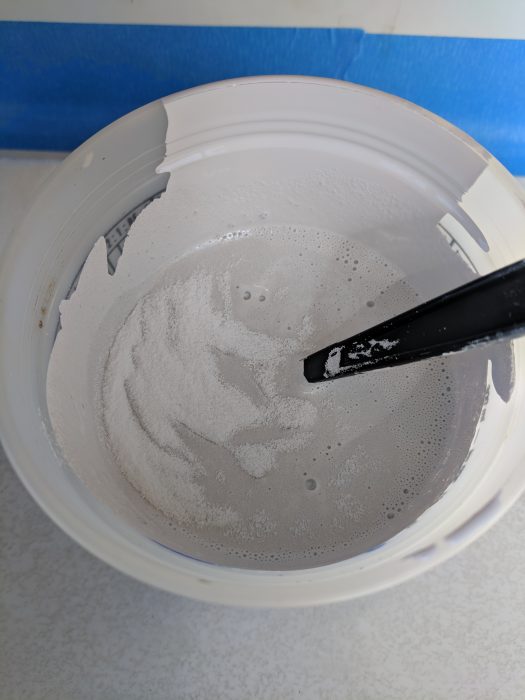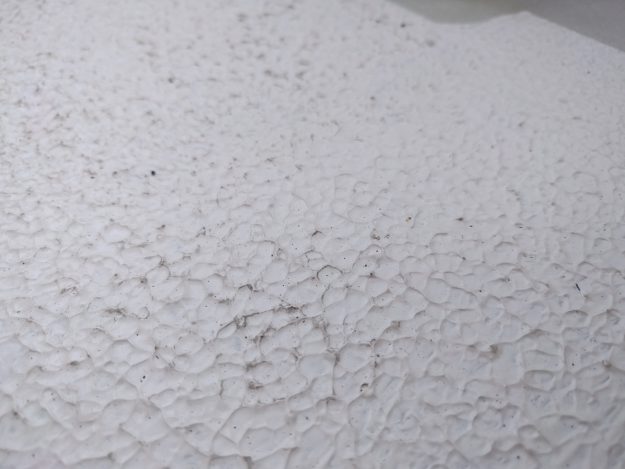A year ago we wrote about our experiences with KiwiGrip non-skid paint and how we were pretty unhappy with it because the sharp ridges trap dirt very tenaciously, making the paint appear permanently dirty, even after cleaning.
For our next non-skid experiment, we had a few ideas of other kinds to try. Finally a year later, we took advantage of some sunny days in March and tried out Interlux Brightside + Interlux non-skid additive (called Intergrip).

Happily, this non-skid looks much better than KiwiGrip and isn’t really even harder to apply. It seems we’ve found the right non-skid for our personal preferences. Of course, we still need to wait a few years to see if it’ll hold up to the test of time / use. But all the reviews indicate it will (we steered clear of Interlux Interdeck, a premixed kind of non-skid, due to reviews saying it doesn’t hold up as long).
Note Intergrip should not be confused with Interdeck. Intergrip is their silica additive you mix with paint, and Interdeck is the 1-part non-skid paint. If you’re buying it in person though you’ll know you have Intergrip by its weight in your hand – it weighs hardly anything compared to paint (which is heavy).

Application
There is a learning curve to applying Interlux non-skid (as there is with KiwiGrip as well) and some of the subtleties I picked up doing it weren’t apparent in the paint instructions or things I’d read online.
The Interlux non-skid additive has instructions on the can saying you can do either a mix-in method (where you mix it with the paint and then roll that on) or a broadcast method where you roll on naked paint and then scatter or sift sand on top of it. Or do a combination of both (broadcast on mixed-in paint).
I had planned on doing the combo approach, having heard online recommendations for that, but with the mix-in ratio I used I found it rolled on with a nice texture and plenty of non-skid, so I don’t think broadcasting additional additive is really necessary, and it would make more of a mess (plus more likely to create uneven distributions).

Coverage and Mixing
I bought a quart of Brightside in Matterhorn White (available on Amazon sometimes) and a half pint (8 oz) of Intergrip non-skid additive ($15). The additive says to use 4 – 6 oz per quart of paint, and I used about 3/4 of the additive (6 oz) and only slightly more than 1/2 of the quart of paint. So I was definitely leaning towards the higher side of that range or slightly beyond it.
Finding the right mixing ratio is a bit tricky. You’ll want a paint measuring cup with volume indicators on the side for measuring the paint. For the non-skid additive I just used a plastic spoon and guesstimated, aiming to use up about 1/2 of the 8oz can.
At the high end of the recommended range, I noticed in the first few strokes of the roller the additive pooled and overapplied a bit – making a sandy looking patch in the paint. You can cover this up in the second coat though by using pure paint over it or less dense non-skid.
The quart of paint covered most of our cockpit (not the floor, which has KiwiGrip). I did two coats on all surfaces. I waited only 3-4 hours between the two coats, because the paint was drying very fast in the sunny 60-65 F afternoon conditions. The Interlux instructions said to wait 24 hours between coats but I didn’t feel that was necessary given how fast it was drying – so I took this shortcut because it would save a lot of trouble (rollers / brushes would harden overnight, dew / dust would get on the paint, the tape might be harder to pull with the 1st coat fully dried, and there’s always risk of rain in Seattle).

Appearance
Interlux Brightside with non-skid additive produces a finely textured surface which is very similar to the existing non-skid on the rest of our deck. This is in stark contrast to KiwiGrip with its pointy ridges. I realized my thought process in selecting KiwiGrip previously was based on a misunderstanding that non-skid needs to have rough, visible texture in order for it to be grippy. My thinking was, the more texture, the better. Now I realize this probably isn’t true – grip in wet conditions can be created even by a fine texture. Large, sparse ridges aren’t necessarily better than small, finely spaced bumps.

KiwiGrip – note the sharp ridges

New Interlux non-skid – a finer sand-like texture
One other thing to note is color matching is hard. If you’re trying to get an exact match to your existing paint or gelcoat, you may want to paint a test patch first (but this will require buying and possibly not using a quart of paint). We used the Interlux paint brochure which has a color matching tool, but although Matternhorn White appeared to be the closest match in the brochure, when actually painted it came out whiter than expected. No big deal, but if you’d rather go darker than your existing paint, I’d recommend picking a darker shade than you think you need.
Painting is one of the more fun and rewarding boat projects. Although it’s fairly time consuming, it’s relatively easy and produces immediate, visible results. It’s relaxing and simple enough you can have a beer while painting (but maybe wait for the second coat for that when you know what you’re doing!). Our cockpit coaming was so slick we mostly just avoided stepping on it – so this project wasn’t only a cosmetic improvement, it provides a safety benefit as well.

Thanks for the info. We too were considering Kiwigrip but decided to revert to Interlux. I’ll plan to go with a little less aggressive mix ratio, in the 6oz per qt range. I’ve had good results with Interlux; our previous paint job lasted about 12 years, but we kept sailing for another ….err, well, I’m embarrassed to say.
Did adding the non-skid additive help with the naturally high gloss sheen of the interlux brightside? My concern is blinding myself with too much high-gloss on the deck.
We never had any issue with the Interlux being shiny or high gloss. It does say it’s a high gloss paint but I suspect the rough surface with the non-skid additive defeats that aspect.